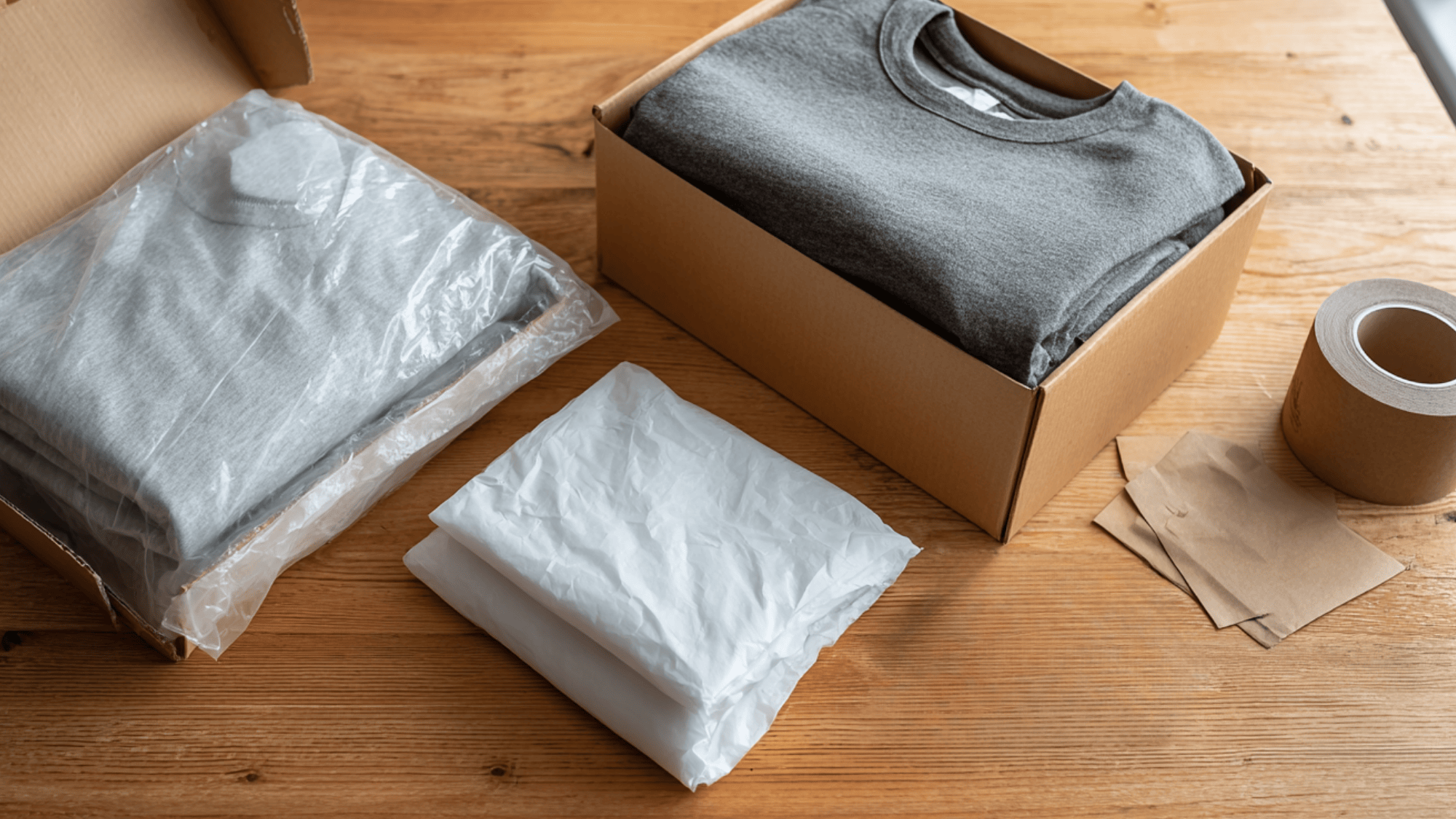Shipping clothes might sound simple, but I’ve learned there’s a lot to consider if you want to save money and keep items safe.
The way you pack, the carrier you choose, and even the type of bag or box can change the cost and speed of delivery.
For lightweight items, a small poly mailer may be enough, while bulkier shipments often need sturdy boxes or even freight services.
I also found that online selling, moving, or sending clothes overseas each has its own best method.
In this blog, I’ll explain the cheapest ways to ship clothes, share cost examples, and give practical tips so you can choose the option that works best for your needs.
What Do You Understand by Shipping?
Shipping refers to the process of sending items from one location to another using a carrier such as USPS, UPS, FedEx, or a freight company.
It’s the process that moves a package from the sender’s hands to the receiver’s doorstep.
When it comes to shipping clothes, the process can be as simple as mailing a single shirt in a poly bag or as complex as moving multiple boxes across the country.
The method chosen depends on the weight, size, distance, and the required delivery speed.
Cheapest Ways to Ship Clothes by Package Type

If you are wondering how to ship clothes in the cheapest way, these are the different shipping methods you can use:
1. Lightweight Clothing (under 1 lb)
For single items like t-shirts or a dress:
- USPS First-Class Mail is the most affordable option. It works for packages up to 15.9 oz.
- Poly mailers keep the weight low and protect clothing.
- Example: A 10-oz package costs around $4–$5 with USPS First Class in 2025.
2. Medium Packages (1–15 lbs)
When shipping sweaters, jeans, or several shirts:
- The USPS Priority Mail Flat Rate Envelope works well if items fit inside. One price, no matter the distance.
- UPS Ground is another suitable option for medium-sized packages.
Comparison snapshot (current average):
- USPS Flat Rate Envelope: about $9.90
- UPS Ground (5 lbs, cross-country): about $12–14
3. Heavy or Bulky Clothing (15+ lbs)
For coats, shoes, or a box of clothes:
- FedEx Ground often beats USPS on heavy packages.
- UPS Ground is also a cost-effective option for shipments weighing between 15 and 70 pounds.
Example: A 20-lb box shipped from NY to CA with UPS Ground costs around $28–32 in the current year.
4. Shipping Multiple Boxes
When you need to send a whole wardrobe:
- USPS Retail Ground, UPS Ground, or FedEx Ground are the go-to choices.
- For large quantities, consolidated freight services like TSI or uShip can reduce costs by bundling shipments.
This makes sense if you’re moving or shipping 100+ lbs of clothes at once.
A Few Special Scenarios of Clothing Shipments
Not every shipment is the same. The cheapest way to ship clothes can vary depending on whether you’re moving, selling online, or sending packages overseas.
Shipping Clothes for Moving
If you’re relocating, carriers like UPS or FedEx are acceptable for a few boxes. Freight services are often more cost-effective for shipping multiple containers at once.
Example: Three boxes weighing 50 lbs each might cost $150–$180 with UPS. Freight services can reduce the total to $120–$140.
Selling Clothes Online
Marketplaces often have their own rules:
- eBay Choose USPS First Class or Priority. Poly mailers are the cheapest.
- Poshmark offers flat-rate USPS Priority labels to sellers.
- Depop lets you buy discounted USPS labels directly.
The best choice is lightweight poly mailers that reduce costs and are easy to handle.
Shipping Clothes Internationally
Costs rise fast when sending abroad:
- USPS First-Class International is the most affordable option for packages weighing under 4 pounds.
- DHL and FedEx are faster but more expensive.
- Customs fees may apply depending on the destination.
Tip: Use compression bags to fit more items into a lighter package.
How to Ship Clothes the Right Way

Knowing how to ship clothes correctly can save money and keep items safe and secure. Below is a simple process anyone can follow:
- Fold and pack neatly: Roll or fold clothes tightly to save space. Rolling also helps prevent wrinkles. Place delicate items inside tissue paper for extra care.
- Choose the proper packaging: Use poly mailers for lightweight and soft clothing, such as t-shirts or leggings. Select boxes for coats, shoes, or fragile items that require additional protection. Adding a waterproof liner inside helps keep clothes safe from rain.
- Weigh and measure: Always weigh and measure your package before printing labels. Even a small mistake can result in a higher shipping rate. A simple kitchen scale is ideal for weighing small items.
- Select a carrier: The USPS is usually the most cost-effective option for light packages weighing under 1 pound. UPS and FedEx offer better rates for heavier boxes. If you’re moving or shipping many boxes at once, freight services often save the most.
- Print labels online: Buying labels on USPS, UPS, or third-party platforms like Pirate Ship and Shippo can give you discounted rates. It also saves time at the post office.
Factors That Affect Clothing Shipping Costs
Before choosing a carrier, it’s essential to understand what factors contribute to shipping costs. Knowing these details helps you compare options and pick the most budget-friendly choice for your package.
- Weight and dimensions: Shipping rates increase with weight and volume. Carriers also use “dimensional weight,” which means that large but light packages may cost more because they occupy extra space. Oversized boxes often incur additional handling fees.
- Distance (zones): Carriers divide locations into zones. The farther your clothes have to travel, the more zones they cross, which raises the price. Sending a box across the country costs much more than shipping it to a nearby state.
- Delivery speed: Faster options, such as 2-day, overnight, or same-day delivery, are always more expensive. Standard ground shipping is slower but usually the cheapest choice if time isn’t urgent.
- Packaging (box vs. bag): Boxes protect items better, but they also add weight, which can increase the cost. Poly mailers and padded envelopes are lighter and cheaper but don’t offer the same protection for bulky or fragile clothing.
By considering these factors, it becomes easier to select shipping options that are both accurate and affordable.
Small choices, like using a lighter mailer or opting for ground shipping instead of priority, can make a significant difference in your costs.
Box vs Bag: Which is Cheaper?
Both boxes and bags can be used for shipping clothes, but the costs and benefits differ. This table makes the choice easier:
| Feature | Poly Bag / Mailer | Cardboard Box |
|---|---|---|
| Cost | Cheaper (lightweight, lower postage) | More expensive (adds weight) |
| Weight | Very light | Heavier, adds extra pounds |
| Protection | Minimal (good for soft items) | Strong protection for bulk or fragile clothing |
| Size Flexibility | Flexible, can squeeze items | Fixed size, may need extra padding |
| Best For | T-shirts, dresses, jeans, small orders | Coats, shoes, large loads, delicate items |
| Eco Options | Biodegradable mailers available | Recyclable if reused properly |
Bags are usually the most affordable choice for small, soft items of clothing. Boxes are worth it when shipping bulkier or fragile items that need more protection.
Shipping Clothes: Cost Examples
When you’re planning to ship clothes, whether across the country or overseas, it really helps to know what to expect.
| Scenario | Carrier & Service | Weight/Box | Estimated Cost | Notes |
|---|---|---|---|---|
| Cross-Country (U.S.) | UPS Ground | 2 lbs | $10.83 | From New York to California |
| USPS Ground Advantage | 2 lbs | $9.90 | Slightly cheaper than UPS | |
| Medium Box (U.S.) | USPS Priority Mail Flat Rate (Medium) | Up to 70 lbs | $8.45+ | Best if box is dense and fits |
| International (Canada/UK) | USPS First-Class International | 2 lbs | $30 | Affordable for small items |
| USPS Priority Mail International | 2 lbs | $48 | Faster, more coverage | |
| USPS Flat-Rate International Box | Up to 20 lbs | $30.90+ | Price depends on box size |
These real-life examples show that USPS is often cheaper for lighter or dense items, particularly with their flat-rate options.
UPS Ground can be a good choice for heavier or cross-country mainland shipping, while USPS also remains strong for international mail – especially for smaller items.
Real-Life Shipping Case Studies
Real numbers make it easier to understand how shipping costs actually play out. Here are a few quick examples from real situations in 2025.
Case Study 1: Small Package (Resale Item)
A seller shipped a 2-lb t-shirt from New York to Los Angeles using UPS Ground.
The cost was approximately $10.80 in 2025. For small to medium-sized items, UPS Ground can be a cost-effective alternative to priority shipping.
Case Study 2: Moving Multiple Boxes
A family relocating with four boxes of clothes, each weighing 40 lbs, compared carriers.
UPS Ground would have cost around $320 total, but switching to a freight service brought the cost down to about $245. That’s a savings of more than $75 for the same shipment.
Case Study 3: Bulk Parcel vs Freight
Shipping dozens of pounds of clothing, I noticed that parcel services were adding up quickly.
By moving to LTL (less-than-truckload) freight, the cost per pound dropped significantly. In cases like this, freight shipping becomes the cheaper and smarter choice.
These examples illustrate how the most cost-effective way to ship clothes can vary depending on package weight and purpose.
Eco-Friendly & Practical Packaging
Choosing the proper packaging doesn’t just save money; it also helps reduce waste. With a few smart swaps, you can protect your clothes, spend less, and still be kind to the planet.
- Biodegradable mailers: These are lightweight, durable, and break down more quickly than traditional plastic mailers. They’re perfect for shipping t-shirts, leggings, or other soft clothing without adding extra weight.
- Reusable boxes: Instead of buying new boxes every time, reuse sturdy ones you already have from past deliveries. If you ship frequently, investing in sturdy, reusable boxes can lower costs in the long run and reduce landfill waste.
- Less filler material: Skip heavy bubble wrap and opt for crumpled kraft paper or tissue paper instead. Using less filler makes the package lighter, which cuts down shipping costs. It also keeps clothes neat without adding bulk.
- Water-based or recyclable tape: Switching from plastic tape to paper-based or water-activated tape makes recycling easier and more eco-friendly.
Eco-friendly packaging doesn’t have to be expensive. In fact, many of these options cost the same or even less than traditional supplies while giving your package a cleaner look.
Final Tips & Recommendations
Choosing the most cost-effective option depends on the weight and purpose:
- USPS for light clothing.
- UPS or FedEx Ground for heavy boxes.
- Freight for moving bulk loads.
- Use online tools and rate calculators to compare costs.
- A simple decision chart or carrier calculator can save time and money.
Conclusion
For me, shipping clothes has always been about finding the balance between saving money and keeping things simple.
Over time, I’ve noticed that the cheapest option really depends on what you’re sending.
If it’s just a lightweight package, go with USPS. When you need to ship heavier boxes, UPS or FedEx usually makes more sense. And if you’re moving or sending a lot at once, freight is the most cost-effective option.
I also save more by using poly mailers, folding items tightly, and taking advantage of online discounts whenever possible. I hope this guide helps you do the same.
Now it’s your turn: compare rates, pick the method that fits your package, and start saving on your next shipment.















